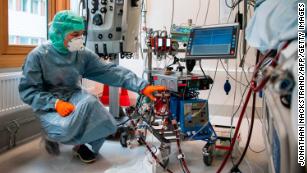Limited Supply Initially
Any vaccine that receives FDA approval is expected to be in limited supply initially, before production ramps up and enough doses become widely available.
“While major efforts are being made to have a significant supply of COVID-19 vaccine as soon as possible, the committee has been tasked with considering the tough choices that will need to be made for allocating the tightly constrained initial supplies,” committee co-chair Dr. Helene Gayle, president and CEO of the Chicago Community Trust and a former HIV/AIDS expert at the Centers for Disease Control and Prevention, said in a statement.
Dr. Eric Toner, a senior scholar at Johns Hopkins Center for Health Security, who was not involved in this report, said the committee was given guidance from the government that they should assume only 10 to 15 million doses of vaccine would be available initially.
“So, given that we have a population of 330 million people in the country, that is a very tiny fraction of people who would be able to have access to vaccine right away,” Toner told CNN.
4 Phase Allocation
The 115-page report recommends allocation in four phases.
- In the first phase, vaccines would go to first responders, high-risk workers in health care facilities as well as people of all ages with conditions that put them at significantly higher risk of bad outcomes and older adults living in dense settings.
- In the second phase the vaccine would be distributed to critical risk workers — workers who are both in industries essential to the functioning of society and at substantially high risk of exposure as well as teachers and school staff.
The second phase would also include people of all ages with conditions that put them at moderately higher risk; all older adults not included in Phase 1; people in homeless shelters or group homes for individuals with physical or mental disabilities or in recovery; and people in prisons, jails, detention centers, and similar facilities, and staff who work there.

Phase one and two combined would cover approximately 45% to 50% of the US population, the report notes.
3. Phase three would include young adults; children; and workers in industries essential to the functioning of society and at increased risk of exposure who were not included in Phases 1 or 2.
4. And phase four would include everyone else.
The Basis Of This Strategy
The draft report goes into detail to explain why the vaccine should go first to the people most at risk of catching it, and of spreading it to others — for example, frontline health workers.
The framework document weighs four different criteria.
- The risk of acquiring and infection: Higher priority is given to individuals who have a greater probability of being in settings where Covid-19 is circulating and exposure to a sufficient dose of the virus.
- The risk of severe morbidity and mortality: Higher priority is given to individuals who have a greater probability of severe disease or death if they acquire infection.
- The risk of negative societal impact: Higher priority is given to individuals with societal function and upon whom other people’s lives and livelihood depend directly and would be imperiled if they became ill.
- The risk of transmitting disease to others: Higher priority is given to individuals who have a higher probability of transmitting the disease to others.
No Priority On Ethnic Minorities
Minority communities, who are at higher risk than Whites, weren’t placed into particular phases based on race/ethnicity, but the underlying circumstances that leave many of them vulnerable were taken into account.
“People of color — specifically Black, Hispanic or Latinx, and American Indian and Alaska Native — have been disproportionately impacted by COVID-19 with higher rates of transmission, morbidity, and mortality.,” the draft report reads.
“Currently there is little evidence that this is biologically mediated, but rather reflects the impact of systemic racism leading to higher rates of co-morbidities that increase the severity of COVID-19 infection and the socioeconomic factors that increase likelihood of acquiring the infection, such as having front line jobs, crowded living conditions, lack of access to personal protective equipment, and inability to work from home,” it adds.
The report makes recommendations similar to those that have come from other groups. Toner’s group at the Johns Hopkins Center for Health Security, released a report last week recommending that frontline health care workers, emergency services personnel and the most vulnerable to the virus should be the first to get any eventual vaccine because “their prioritization would likely avert the greatest overall harm.”
The Centers for Disease Control and Prevention also suggested healthcare workers should be the first to get vaccinated, followed by non-healthcare essential workers, then adults with medical conditions who are at higher risk for severe Covid-19, and people aged 65 and older. The CDC’s Advisory Committee for Immunization Practices is expected to release its own report.
Toner said he has “nothing but praise” for this draft framework.
“I think they do a very credible job, walking through the ethical principles and the rationale for prioritizing certain groups over others,”he said.
“They talk about doing the most good– maximizing the benefits of the vaccine –by giving it to people who are essential to providing care to others during the pandemic, so for health care workers for example. And also prioritizing those people who are at greatest risk — and that is greatest risk of getting the disease or transmitting the disease or of succumbing to the disease if they get infected.”
There will be a public comment period open until 11:59pm on Friday, September 4. The NAS will hold a five-hour-long listening session on Wednesday for the public to ask questions to the study committee directly.
Did you subscribe to our daily newsletter?
It’s Free! Click here to Subscribe!
Source: CNN




















